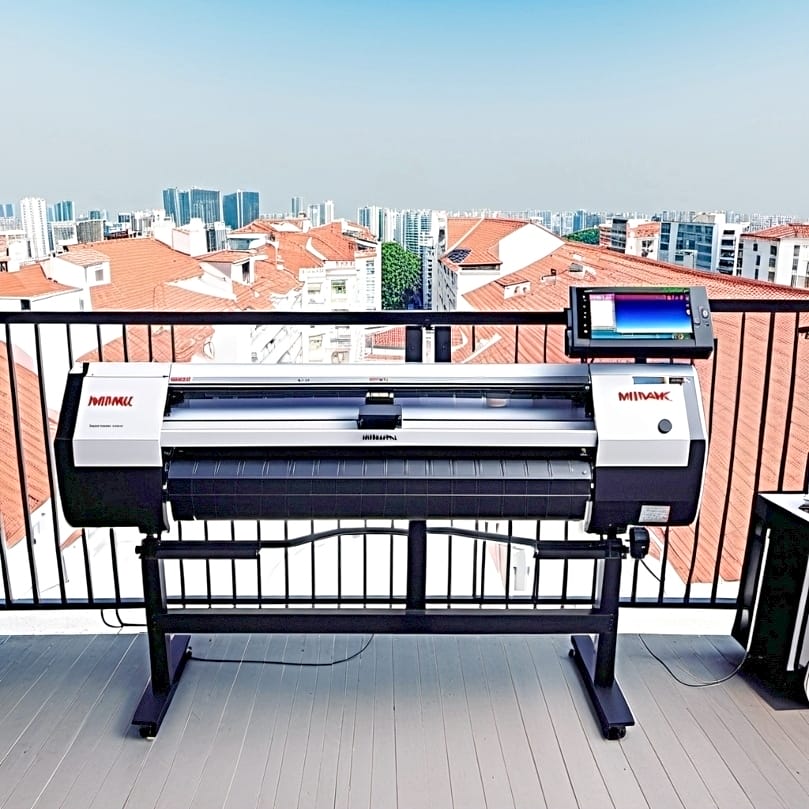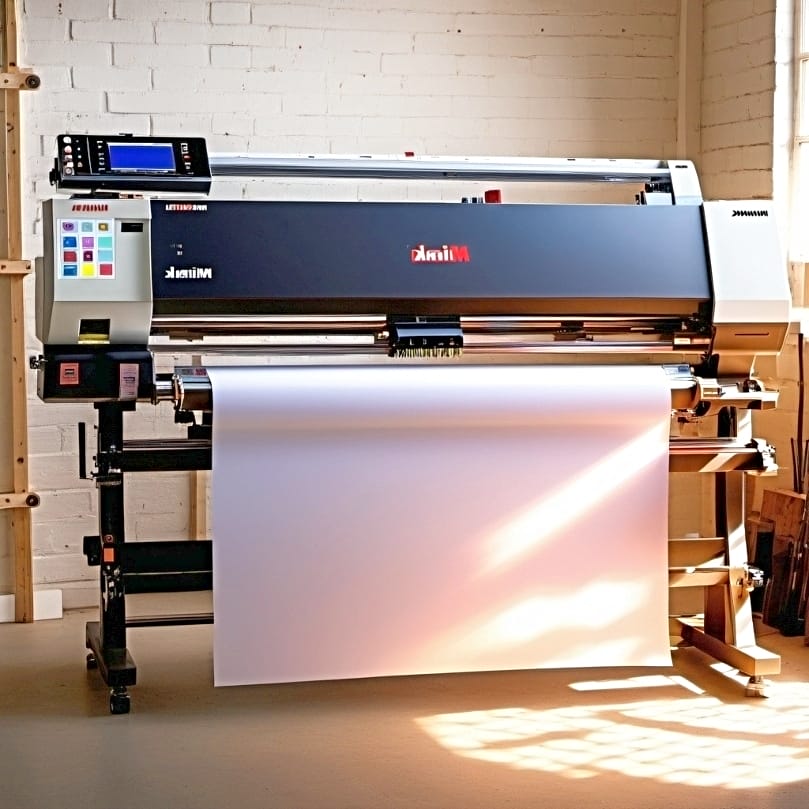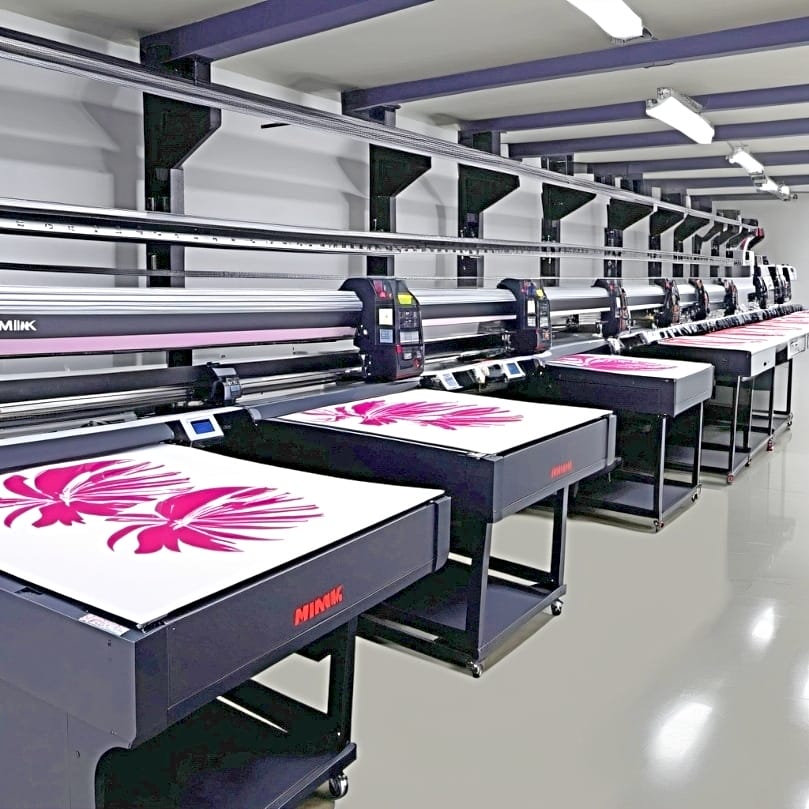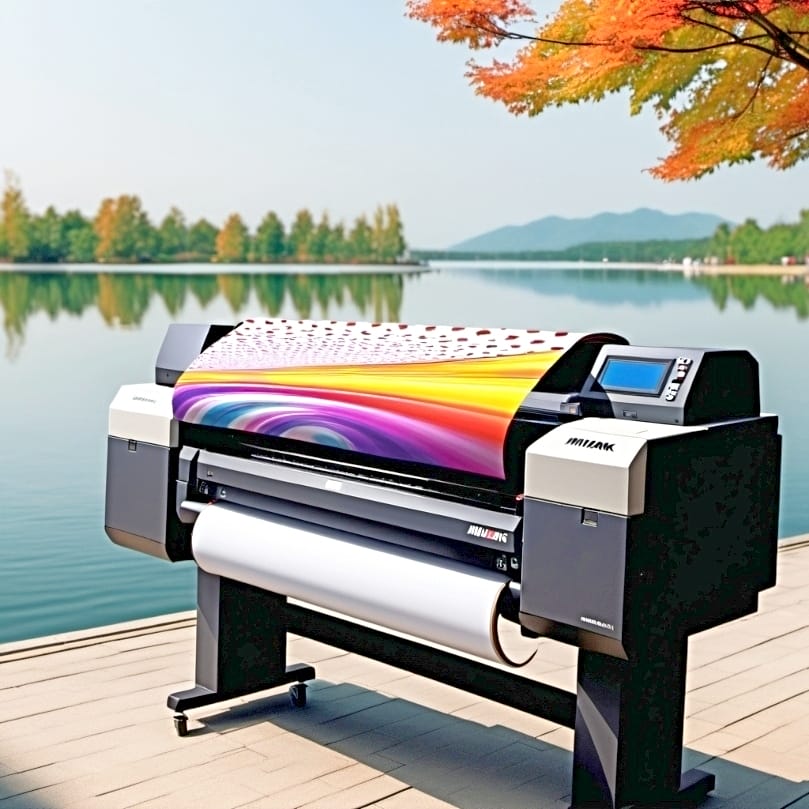Table of Contents
ToggleReady to bring your textile designs to life with a Mimaki sublimation printer? Yes? Well, read on as we explain the process to setup and use Mimaki sublimation printers efficiently with our in-depth guide. From connecting the printer to finalizing your first print, we’ll provide the clear steps you need to start printing without the guesswork. Geared for optimal simplicity, let’s get you up and running quickly and without hassle. Enjoy the Mimaki sublimation adventure!
Key Takeaways
- Mimaki sublimation printers employ advanced inkjet technology for high-quality, full-color digital printing on textiles, reducing waste and allowing for intricate designs on diverse materials, including polyester fabrics and rigid substrates like aluminum and glass.
- Key setup steps for Mimaki printers include ensuring stable placement for accuracy, proper electrical connections for safety, calibration for precise color reproduction, and software updates for optimal performance. An uninterrupted ink supply system and rip software configuration are critical for efficient, continuous operation.
- Maintaining a Mimaki sublimation printer involves regular usage to prevent ink clogs, correct shutdown procedures, and quick responses to printer issues. Fabric preparation and advanced systems, like the Advanced Pass System (MAPS) and Nozzle Recovery System (NRS), are essential for achieving high-quality prints. The Mimaki TS100-1600 is an example of a Mimaki sublimation printer.
Understanding Mimaki Sublimation Printers

Mimaki sublimation printers are more than just another piece of technology, they are the gateway to a world of endless creativity. Not only do they enable full-color digital printing, but they also produce high-quality photographic images without the need for halftone dots. This innovative technology is environmentally friendly, eliminating the need for screens and emulsions and reducing associated waste.
The versatility of these printers is astounding, capable of creating intricate designs on a range of materials from polyester textiles to rigid substrates like aluminum and glass. Whether you’re producing custom textiles for goods, interior decorations, or even cosplay, Mimaki printers have got you covered.
Inkjet Printer Technology
Mimaki sublimation printers owe their success to their cutting-edge inkjet technology. This technology allows printing on transfer paper or directly onto pretreated fabrics. The sublimation dyes used are designed to vaporize and penetrate polyester fabrics upon heating, resulting in vibrant and durable prints.
However, the magic doesn’t stop there. Pre-treating fabrics with a suitable primer enhances printability and color vibrancy for textiles in the sublimation printing process. Using only the recommended sublimation ink is imperative to maintain optimal performance and prevent damage to your Mimaki inkjet printer.
Dye Sublimation Process
Now, let’s delve into the fascinating process that brings your designs to life. It all begins with sublimation inks, acting as a solvent, transitioning from solid to gas under heat, creating a strong bond with the substrate material. This chemical process results in vibrant, durable prints that withstand multiple wash cycles without fading, cracking, or peeling. Read more about whether inks used for sublimation are toxic.
⫸ Click Here For Best Selling Sublimation Printers And Products ⫷The dye sublimation process involves molecular chains of the fibers breaking on heating, capturing sublimated ink molecules and fixing them onto the fabric. This process requires heat at temperatures between 350°F and 450°F, allowing the ink to permeate the fabric and solidify within its fibers. The resulting prints are not only vibrant but also highly detailed, allowing for complex designs without any compromise on quality.
Setting Up Your Mimaki Sublimation Printer

Acquiring a Mimaki sublimation printer is just the beginning; the next step is setting it up. First things first, ensure the printer is placed on a stable and level surface to minimize printing inaccuracies. During setup, ensuring proper ventilation and a controlled ambient temperature in the printer’s environment is vital.
When connecting your printer, utilise the original Mimaki power cord and connect it to a grounded power supply to avert electrical hazards. Calibration is a key part of the initial setup to ensure precise color reproduction and print head alignment.
Finally, don’t forget to perform firmware and software updates to enhance the printer’s performance and rectify any known issues.
RIP Software Installation
The right software can make all the difference when it comes to achieving desired print quality. RIP software helps create designs that are printed on sublimation paper and subsequently transferred onto materials. Users can download profiles designed for specific media and ink types from the Mimaki website. Adjusting printer settings requires these profiles.[1]
The appearance of colors on the fabric can be improved by adjusting the overprint settings in the RIP software. This allows for heightened ink density or layered colors. Regular calibration of the printer for linearization ensures consistent color output across different fabric types, by tweaking ink limits and dot gain.
Uninterrupted Ink Supply System Setup
One of the standout features of Mimaki printers is the Uninterrupted Ink Supply System (UISS). This system seamlessly switches to a new ink cartridge to facilitate continuous printing. For mass production needs, large-capacity ink bottles can be utilized with Mimaki’s sublimation printers, allowing for extended operations without the need for frequent ink cartridge replacements.
The real beauty of the UISS lies in its ability to:
- Replace ink cartridges during live printing jobs, such as overnight executions
- Add to the efficiency of production without introducing downtime
- Activate cartridge switching at crucial moments based on various conditions, like the detection of ink depletion and errors
- Ensure an uninterrupted printing process
Using Your Mimaki Sublimation Printer

Regular usage is instrumental in guaranteeing the longevity and optimal performance of your Mimaki sublimation printer. Why? Because it keeps the ink flowing smoothly and reduces the risk of clogged print heads. Turning off the printer correctly is equally important. This practice is pivotal in preserving the health of the ink nozzles as it prevents them from drying out or clogging.
However, even with the best care, issues can occur. When clogged print heads do happen, the printer’s built-in cleaning function is the first line of defense. But if necessary, manual cleaning with a suitable solution can be carried out. Promptly addressing any unusual printer behavior, such as unexpected noises, error messages, or changes in print quality, can help prevent more serious issues.
Loading and Preparing Fabrics
The preparation of your fabrics can significantly impact the final appearance of your printed design. Properly prepared pre-coated fabrics specifically designed for ink reception yield the best results when using Mimaki sublimation printers. For successful fabric printing, you should:
- Ensure that the material is evenly loaded into the printer
- Properly manage tension on the take-up reel
- Utilize the correct platen or feed system based on the type of fabric
Refraining from touching or disturbing the garment fabric during the printing process is vital. This ensures the integrity of the print without any distortion or smudging.
Advanced Pass System and Nozzle Recovery System
Mimaki’s Advanced Pass System (MAPS) and Nozzle Recovery System (NRS) are two key features that enhance print quality and reliability. The benefits of these features include:
- MAPS uses an advanced algorithm to mitigate visible banding and uneven color printing, creating a gradation-like effect on prints.
- NRS ensures that if a nozzle becomes clogged or misfires, the printer can continue printing without any interruption or loss of quality.
- Enhanced with MAPS4, the Tx300P-1800 MkII printer delivers superior quality prints with reduced banding.
The Nozzle Recovery System (NRS) offers the following benefits:
- Allows operators to replace non-functioning nozzles, preventing compromised image quality
- Reduces the need for service calls
- Supports continuous and unattended printing operations, fortifying printer reliability.
Adjusting Print Settings
Adjustment of print settings is key to optimizing print quality and efficiency across different fabric types and designs. The heat setting on the sublimation printer must be adjusted to match the fabric type for effective ink fixation and color output. Using high-quality sublimation inks is essential to achieve vibrant colors and long-lasting prints, with good color saturation and UV resistance.
Adjust the print speed by selecting the appropriate scan motor speed; ‘normal’ for quality or ‘fast’ for quicker results. For less detailed work, lower resolution printing profiles, such as 360×540, can balance print speed with acceptable quality.
Bi-directional printing with an optimal number of passes, like 12 passes on PVC Matte media, can ensure high-quality results on various media types.
Tips for First-Time Users

The array of features and capabilities offered by Mimaki sublimation printers may seem overwhelming to a first-time user. Fear not, we’re here to help navigate through your initial steps. Mimaki sublimation printers are versatile, making them suitable for both small and large volume orders. This provides cost efficiency for businesses with continuous stock replenishment and one-off productions.
The Mimaki TS100-1600, for example, enables on-demand printing, which helps manufacturers to produce new fabric designs in just the right volume, reducing waste and inventory costs.
Choosing the Right Ink and Media
To achieve vibrant colors, a wide color gamut, and long-lasting prints on textiles, it’s imperative to select the right sublimation ink and media. Here are some tips to consider:
- Ensure the sublimation ink selected is compatible with the specific Mimaki printer model to achieve the best printing results.
- For a broad color spectrum on textiles, use sublimation inks that offer a wide color gamut, including blue magenta yellow and fluorescent pink.
- Consider fluorescent inks for more vivid prints.
Choosing high-quality sublimation paper can improve the absorption and release of ink, enhancing the overall print quality. It’s recommended to conduct tests with different inks and papers to find the optimal combination. Lastly, store inks and sublimation paper in a cool, dry place away from direct sunlight, and handle the paper by the edges to avoid transferring oil and dirt.
Maintaining Your Printer
The performance and longevity of your Mimaki sublimation printer greatly depend on its maintenance. Before starting the printer, ensure to check and clean all moving parts and the print head to prevent obstructions that could affect printing quality. The Ink use-up cleaning function can be used to minimize ink waste by consuming almost empty cartridges before they are replaced.
To effectively track past upkeep and schedule future maintenance, it’s beneficial to maintain a log of all printer maintenance activities. With regular maintenance, your printer will continue to deliver high-quality prints for a long time.
Popular Mimaki Sublimation Printer Models

Mimaki offers a range of sublimation printers, each designed to meet different needs within the textile printing industry. Their latest models include:
- TS330-1600: released in April 2022, highlights the ongoing evolution of their printing technology
- TS100-1600: can achieve speeds up to 753 square feet per hour
- TS55-1800: reaches 1,506 square feet per hour with Sb610 inks
The TS300P-1800 and JV300 Series are particularly popular for their high-speed capabilities and versatility in sublimation printing on textiles. Each model comes with a unique set of features and capabilities to cater to a variety of needs and preferences.
TS100-1600 Sublimation Printer
The TS100-1600 is an affordable sublimation printer designed for entry-level users. It offers the following features:
- Maximum print speed of 70 square meters per hour
- Maximum print width of 1,610 mm
- Suitable for diverse printing tasks such as fashion, sportswear, and soft signage
With these features, the TS100-1600 provides efficient production output, making it well suited for newcomers to textile printing, as well as for those who are already well suited in the industry.
The printer utilizes Mimaki’s Sb610 inks, including yellow, to achieve vibrant colors and fine detail resolution in prints, enhancing the overall quality of the output. This model is an ideal choice for those looking to venture into the world of textile printing without breaking the bank.
Tx300P-1800 MkII
On the other end of the spectrum is the Tx300P-1800 MkII, a versatile textile ink printer suitable for a range of textile printing applications. What sets this model apart is its support for various ink combinations including textile pigment/sublimation transfer, direct sublimation/sublimation transfer, or textile pigment/direct sublimation, catering to different printing needs.
These ink combination options, including magenta yellow and black, enable compatibility with various fabrics, making the Tx300P-1800 MkII a flexible choice for textile producers. Whether you’re printing on polyester, cotton, or silk, this printer has got you covered.
Summary
In conclusion, Mimaki sublimation printers offer a world of possibilities for textile printing. From their advanced inkjet technology, eco-friendly printing process, and versatile capabilities to their user-friendly setup and maintenance procedures, these printers are truly a game-changer in the industry. Whether you’re a newbie venturing into textile printing or a seasoned professional looking to upgrade your equipment, Mimaki has a printer that suits your needs. So why wait? Dive into the colorful world of textile printing with Mimaki sublimation printers and let your creativity soar! Don’t miss our guide on comparisons of Mimaki sublimation printers! I also have a guide containing instructions on the set up and use of a Mitsubishi sublimation printer and DNP sublimation printer set up and use.
Frequently Asked Questions
How does Mimaki printer work?
The Mimaki printer works by using a special transfer paper with solid ink, which is pressed against the medium and dispersed into the porous material through high heat and pressure. This differs from an inkjet printer where liquid ink solidifies on top of the printed media.
How do I use my printer for sublimation?
To use your printer for sublimation, preheat your press, lint roll your blank, add protective paper, tape your design into place, and then press with your heat press. This will ensure a successful sublimation project.
What is the best file format for sublimation printing?
The best file format for sublimation printing is PNG. It preserves transparency, maintains resolution, and is a modern, universal format. Choose PNG when saving your print files for sublimation printing.
What makes Mimaki sublimation printers different from other printers on the market?
Mimaki sublimation printers stand out due to their advanced inkjet technology, versatile printing capabilities, and eco-friendly processes, allowing for high-quality prints on a range of materials.
How does the Uninterrupted Ink Supply System (UISS) work?
The Uninterrupted Ink Supply System (UISS) works by seamlessly switching to a new ink cartridge to enable continuous printing, activated based on conditions such as ink depletion and errors, ensuring uninterrupted printing.
References
- Booth, H. V. (2023a, April 28). What Is RIP Software? How to Use It for Printing. What Is RIP Software? How to Use It for Printing. https://largeformat.hp.com/in/blog/what-is-rip-software-how-to-use-it-for-printing














